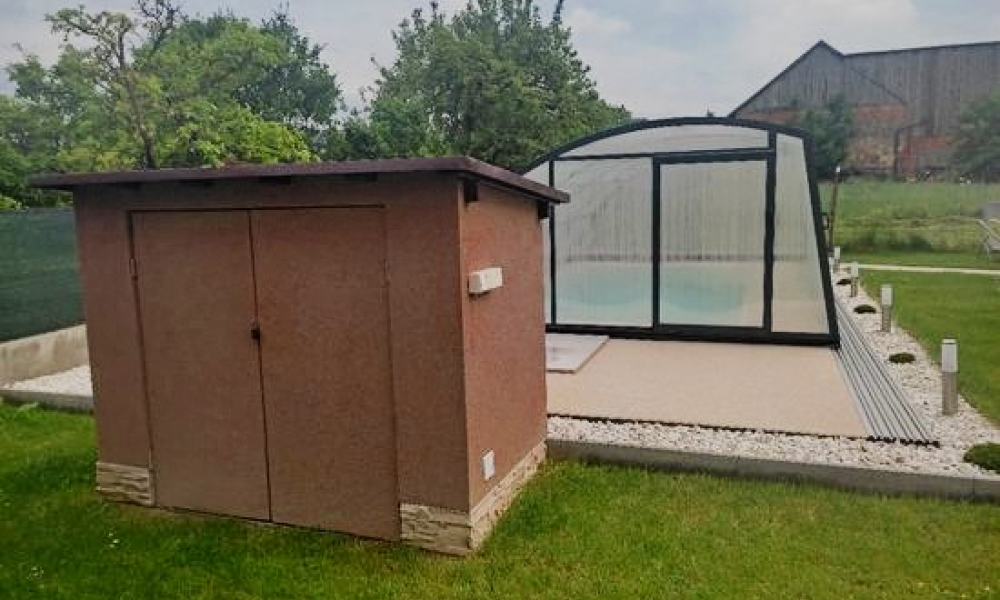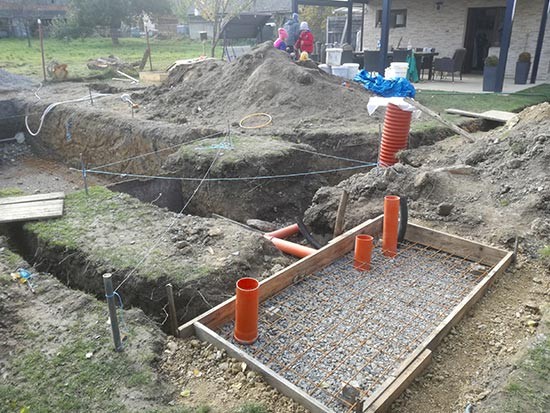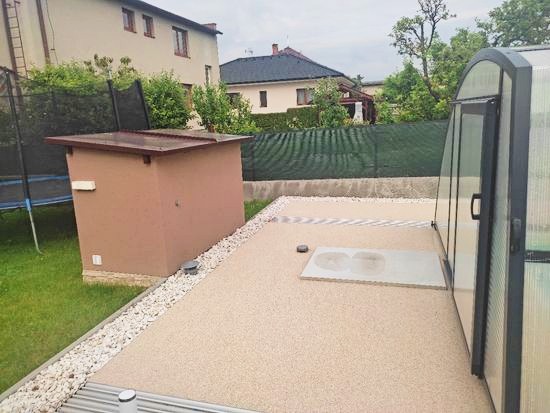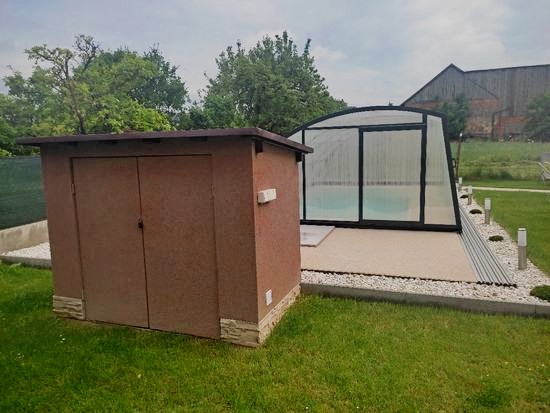
Where to store the pool technology? In the shaft or in the outhouse?
This is a question for which there may not be a clear-cut answer, and you may ponder for a while whether to choose one option or the other. The choise whether to place the technology, along with the counterflow, in a hidden spacious underground shaft that wouldn't take up space in the garden, or in an above-ground small house measuring 2 x 1 meters. The advantages and disadvantages of both solutions, as well as the construction and equipment of the garden house intended exclusively for pool technology.
Foundation slab
The small house stands on a reinforced concrete foundation slab, which is 10 cm high, with a compacted layer of crushed stone underneath for drainage, extending 15 cm deep. Before its construction, prepare the connection to the sewer system, to which the filtration system is connected, as well as openings for the incoming and outgoing pipes. Here use 20 cm diameter DN elbows, through which flexible pipes are connected during the pool installation. Place a bubble wrap film around the concrete for separation from the surrounding soil and add protection against water. Construct the foundation slab together with the pool's foundation slab. Extend the water supply to the filtration system for refilling the pool. This way, you don't have to drag a hose to the pool.

Insulation
The small house is insulated with 5 cm of extruded polystyrene. The insulation not only minimizes freezing in winter and overheating in summer but also provides soundproofing. The motor of the filtration system can be noisy.Apply a facade to the house, matching its appearance.
Ventilation and other tricks
There are two ventilation grilles installed in the small house to ensure proper air circulation. Through the wall facing the pool, a plastic pipe is extended. Use this pipe to thread the cable of the pool vacuum cleaner. The unit of the robotic vacuum cleaner is hung in the cool and dry interior of the house, thus protected from any handling, overheating, and rain. Plug the robot's cable into the unit, thread it through the pipe towards the pool, and that's it. Before handle it in the traditional way - connect the vacuum cleaner to an outdoor socket and started the robot. The unit was outside, exposed to the outdoor conditions and the risk of damage from children, tripping over the vacuum cleaner's cable, and subsequent tipping over, etc. This solution made life a lot easier - don't have to worry about whether it's raining, sunny, or if someone is playing with the unit

Space
Even though the small house takes up valuable space in garden, the decision was the right one.When considering the dimensions of the small house, also take storage possibilities into account. Store the robotic vacuum cleaner and pool chemicals in the small house. All the equipment under control and handling everything is convenient. It would be quite challenging to retrieve any equipment or filter sand from the shaft.

Pool counter-current shaft
A shaft in the ground is not a good solution, but you can't do without it when installing a counter-current. Plastic shaft made for the counter-current, which corresponds to the recommended dimensions of the Brilix counter-current manufacturer. Because condensation can occur in the shaft and moisture can form under certain circumstances, address passive ventilation of the shaft. Had two waterproof openings with a diameter of 10 cm made in the shaft - one at the opposite bottom and the other at the opposite top. From these openings, led DN 110 pipes and installed ventilation chimneys on the outlets. The shaft is dry, which is ideal for the counter-current motor.
Reinforcement of the Shaft
When installing a plastic shaft, be very careful about the following. When concreting the shaft, also reinforce it. The shaft should have a collar through which you thread steel rebars and concrete the shaft. On hot days, the shaft start to twist and gaps formed between the concrete and the shaft, and the walls deformed. It could be solved, but only really temporarily. Reinforce the walls of the shaft with steel plates, which screw through the shaft to the concrete. However, risky access points were creat in the shaft, through which rainwater could enter. So be very careful about this and reinforce the plastic shaft.
Drainage and Waterproofing of the Shaft
Under no circumstances should so much water enter the shaft that it floods the motors and control units of the equipment. Recommend to install active ventilation and also an automatic pump in the shaft, which monitors potential flooding and is capable of pumping water out of the shaft before it floods it.
Advantages and Disadvantages of Installation in the Shaft and Garden House
GARDEN HOUSE
Advantages:
Disadvantages:
PLASTIC SHAFT
Advantages:
Disadvantages:
Technology stored directly in the house
In addition to the garden shed and plastic shaft, there's one more solution worth mentioning. It combines the advantages of both previous solutions - installing the technology, for example, in the basement of the house. Not everyone has this option, but it seems to be the most suitable solution - you don't have to build anything, the technology is hidden in warmth and dryness, easier winterization, no risk of flooding, and no need for ventilation. Such a solution practically only has advantages.
